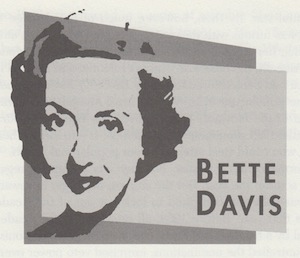
Born: April 5, 1908, Lowell, MA
Died: October 6, 1989, Neuilly-sur-Seine, France
There is something elemental about Bette—a demon which threatens to break out and eat everybody alive.
—John Huston
Unsuspecting director George Cukor had no idea what tenacity he instilled in a young actress in 1928. As head of a theater company in Rochester, New York, he dismissed a girlish Bette Davis and sent her home after an awkward audition. Davis’s mother, furious that Cukor would overlook such genius, marched Bette straight to Broadway, where good reviews in Virgil Geddes’s The Earth Between in 1929 led to her first hit, Broken Dishes, in 1930. Her first Hollywood film, Bad Sister (1931), failed at the ticket office despite a smoldering performance by costar Humphrey Bogart, and her next five films flopped as well. It looked as though Bette Davis would be sent home again. But a Warner Bros. executive felt encouraged by her apparent determination and cast her in the breakthrough The Man Who Played God (1932). She was hailed as a rare screen talent with magnetic eyes and a deep understanding of acting. Warners immediately drafted a long-term contract that made her a lifetime featured player.
After small roles throughout the 1930s, Davis felt Warners was not honoring their agreement; she wasn’t given opportunities in films that showcased her unique gifts. She went to court to break her contract, but in a series of hard-fought, precedent-setting cases, Warners maintained control of the temperamental star. By then, however, much of the damage was already done. Davis was furious with the court’s decision and became unmanageable during filming, her moods on the set turning bitter and despondent. Quite uncharacteristically, the bosses at Warners relented and allowed her to make a picture that had been offered to her by RKO: Of Human Bondage (1934), based on the popular novel by. W. Somerset Maugham. Starring opposite leading man Leslie Howard, Davis delivered a riveting performance that again established her prominence as an actress. It also formed her reputation as a woman who could steal attention from popular male leads.
Her performance in Of Human Bondage was universally regarded as the best by any actor of the year. But the studios, not eager to reward Davis for her rebellious behavior, conspired to lock her out of the Academy Award nominations that year. Before 1934, all nominations for Academy Awards were offered by a hand-picked thirty-five-member team of Louis B. Mayer’s liking. He controlled the nominations, exercised veto power over choices he disliked and doled out special recognition awards. The final ballots went out to roughly fourteen hundred voters, representatives of each trade union in the industry. But when Bette Davis did not appear on the year’s selection, members of the Screen Actors Guild cried foul and threatened to wrest the Oscar ballot procedures from Mayer’s control. SAG president Frank Capra encouraged a write-in campaign, and thousands of voters jotted her name at the bottom of their ballots. Getting wind of the grassroots movement, Mayer quickly changed the Oscar rules to prevent write-ins, and Bette Davis was passed over completely. A furious Capra would commit to a long struggle to democratize the process and by 1941, the envelopes were sealed by independent consultants.
With better parts in Dangerous (1935), Jezebel (1938), Dark Victory (1939) and The Little Foxes (1941), Davis delivered Oscar-winning portrayals and big profits. Her persistent defiance of directors prompted heated battles on many of her sets, and Davis became a prima donna of outlandish proportion. Warners, however, tolerated its genuine institution. Never had Hollywood seen an actress who exuded such feminine strength and masculine aggressiveness on screen. She led the way for Barbara Stanwyck, Jane Fonda and Faye Dunaway, actresses of independent spirit. Her tough-willed stature got her elected as the first female president of the Motion Picture Academy of Arts and Sciences.
The hypnotic Davis eyes, choppy speech and affected mannerisms created a unique persona. The mercurial Joan Crawford enjoyed a similar longevity, both women’s careers spanning five decades, but the Davis legend seemed to accumulate with each fiery role. Her perfectly tempestuous Margo Channing in All About Eve (1950) launched worldwide parodies of her lines and gestures. She would become a singular personality, mocked in animated cartoons and lionized in popular songs.
During the 1960s, she starred in a series of macabre films, notably What Ever Happened to Baby Jane? (1962) and Hush… Hush, Sweet Charlotte (1964); her last appearance was with Lillian Gish in The Whales of August (1987). In 1977, she became the first woman to receive the American Film Institute Life Achievement Award. In all, her hundred film roles reaped ten Academy Award nominations and two Oscars for Best Actress. Her career made her a true role model for women in the film industry, and her incomparable screen performances left the sharpest images of forthrightness ever presented on screen.
To read all the republished articles from ‘The Film 100,’ go to Reintroducing the Film 100 here on Keyframe.




